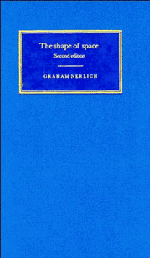Book contents
- Frontmatter
- Contents
- Preface
- Introduction
- 1 Space and spatial relations
- 2 Hands, knees and absolute space
- 3 Euclidean and other shapes
- 4 Geometrical structures in space and spacetime
- 5 Shapes and the imagination
- 6 The aims of conventionalism
- 7 Against conventionalism
- 8 Reichenbach's treatment of topology
- 9 Measuring space: fact or convention?
- 10 The relativity of motion
- Bibliography
- Index
4 - Geometrical structures in space and spacetime
Published online by Cambridge University Press: 04 December 2009
- Frontmatter
- Contents
- Preface
- Introduction
- 1 Space and spatial relations
- 2 Hands, knees and absolute space
- 3 Euclidean and other shapes
- 4 Geometrical structures in space and spacetime
- 5 Shapes and the imagination
- 6 The aims of conventionalism
- 7 Against conventionalism
- 8 Reichenbach's treatment of topology
- 9 Measuring space: fact or convention?
- 10 The relativity of motion
- Bibliography
- Index
Summary
The manifold, coordinates, smoothness, curves
In this chapter I explain some ideas of geometry from a different standpoint and with different aims. The last chapter mainly showed ways to visualise geometry. It moved within a somewhat classical ambit of spaces with constant curvature and rather restricted axioms of incidence. It is time for a broader canvas. This will be more useful if it is tied to more mathematical techniques, to show the advantages of mapping spacetime points into the real-number space of n dimensions, Rn. With luck and application, you will gain some reading skills which will carry you through some of the mathematical parts of the literature. This approach also relates spatial and spacetime geometries together in a fairly intuitive way. Exploiting the notation of partial differential calculus yields a view of local geometric structure, of neighbourhood or infinitesimal structure. Later chapters do not lean very heavily on this one, but you should find it useful to read it. You could skip it and still get rather a lot from the rest of the book. The most accessible books on these topics that I know are Lieber (1936) which starts at a quite elementary level and takes a clear path to sophisticated concepts, Schutz (1980; 1985), the latter being especially useful. They cover a great deal more than is aimed at here. Sklar (1974b) and Angel (1980) are also very helpful. Friedman (1983) and Torretti (1983) are excellent, but advanced, philosophical and mathematical treatments.
In chapter 3 various metrical geometries were found to be subgeometries of projective geometry.
- Type
- Chapter
- Information
- The Shape of Space , pp. 94 - 111Publisher: Cambridge University PressPrint publication year: 1994



